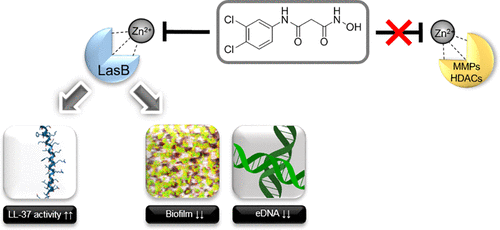当前位置:
X-MOL 学术
›
ACS Chem. Biol.
›
论文详情
Our official English website, www.x-mol.net, welcomes your
feedback! (Note: you will need to create a separate account there.)
Tackling Pseudomonas aeruginosa Virulence by a Hydroxamic Acid-Based LasB Inhibitor
ACS Chemical Biology ( IF 3.5 ) Pub Date : 2018-08-08 00:00:00 , DOI: 10.1021/acschembio.8b00257 Andreas M. Kany 1 , Asfandyar Sikandar 2 , Samir Yahiaoui 1 , Jörg Haupenthal 1 , Isabell Walter 1 , Martin Empting 1 , Jesko Köhnke 2 , Rolf W. Hartmann 1, 3
ACS Chemical Biology ( IF 3.5 ) Pub Date : 2018-08-08 00:00:00 , DOI: 10.1021/acschembio.8b00257 Andreas M. Kany 1 , Asfandyar Sikandar 2 , Samir Yahiaoui 1 , Jörg Haupenthal 1 , Isabell Walter 1 , Martin Empting 1 , Jesko Köhnke 2 , Rolf W. Hartmann 1, 3
Affiliation

|
In search of novel antibiotics to combat the challenging spread of resistant pathogens, bacterial proteases represent promising targets for pathoblocker development. A common motif for protease inhibitors is the hydroxamic acid function, yet this group has often been related to unspecific inhibition of various metalloproteases. In this work, the inhibition of LasB, a harmful zinc metalloprotease secreted by Pseudomonas aeruginosa, through a hydroxamate derivative is described. The present inhibitor was developed based on a recently reported, highly selective thiol scaffold. Using X-ray crystallography, the lack of inhibition of a range of human matrix metalloproteases could be attributed to a distinct binding mode sparing the S1′ pocket. The inhibitor was shown to restore the effect of the antimicrobial peptide LL-37, decrease the formation of P. aeruginosa biofilm and, for the first time for a LasB inhibitor, reduce the release of extracellular DNA. Hence, it is capable of disrupting several important bacterial resistance mechanisms. These results highlight the potential of protease inhibitors to fight bacterial infections and point out the possibility to achieve selective inhibition even with a strong zinc anchor.
中文翻译:

通过基于异羟肟酸的LasB抑制剂处理铜绿假单胞菌的毒力
为了寻找新的抗生素来对抗耐药性病原体的挑战性传播,细菌蛋白酶代表了致病阻断剂发展的有希望的目标。蛋白酶抑制剂的常见基序是异羟肟酸功能,然而该组常常与各种金属蛋白酶的非特异性抑制有关。在这项工作中,抑制铜绿假单胞菌分泌的有害锌金属蛋白酶LasB通过异羟肟酸酯衍生物进行了描述。本抑制剂是基于最近报道的高选择性硫醇骨架而开发的。使用X射线晶体学,缺乏对一系列人类基质金属蛋白酶的抑制作用可归因于保留S1'口袋的独特结合模式。该抑制剂被证明可以恢复抗菌肽LL-37的作用,减少铜绿假单胞菌生物膜的形成,并且对于LasB抑制剂而言,这是首次减少细胞外DNA的释放。因此,它能够破坏几种重要的细菌抗性机制。这些结果突出了蛋白酶抑制剂对抗细菌感染的潜力,并指出了即使使用强锌锚定剂也可以实现选择性抑制的可能性。
更新日期:2018-08-08
中文翻译:

通过基于异羟肟酸的LasB抑制剂处理铜绿假单胞菌的毒力
为了寻找新的抗生素来对抗耐药性病原体的挑战性传播,细菌蛋白酶代表了致病阻断剂发展的有希望的目标。蛋白酶抑制剂的常见基序是异羟肟酸功能,然而该组常常与各种金属蛋白酶的非特异性抑制有关。在这项工作中,抑制铜绿假单胞菌分泌的有害锌金属蛋白酶LasB通过异羟肟酸酯衍生物进行了描述。本抑制剂是基于最近报道的高选择性硫醇骨架而开发的。使用X射线晶体学,缺乏对一系列人类基质金属蛋白酶的抑制作用可归因于保留S1'口袋的独特结合模式。该抑制剂被证明可以恢复抗菌肽LL-37的作用,减少铜绿假单胞菌生物膜的形成,并且对于LasB抑制剂而言,这是首次减少细胞外DNA的释放。因此,它能够破坏几种重要的细菌抗性机制。这些结果突出了蛋白酶抑制剂对抗细菌感染的潜力,并指出了即使使用强锌锚定剂也可以实现选择性抑制的可能性。











































 京公网安备 11010802027423号
京公网安备 11010802027423号